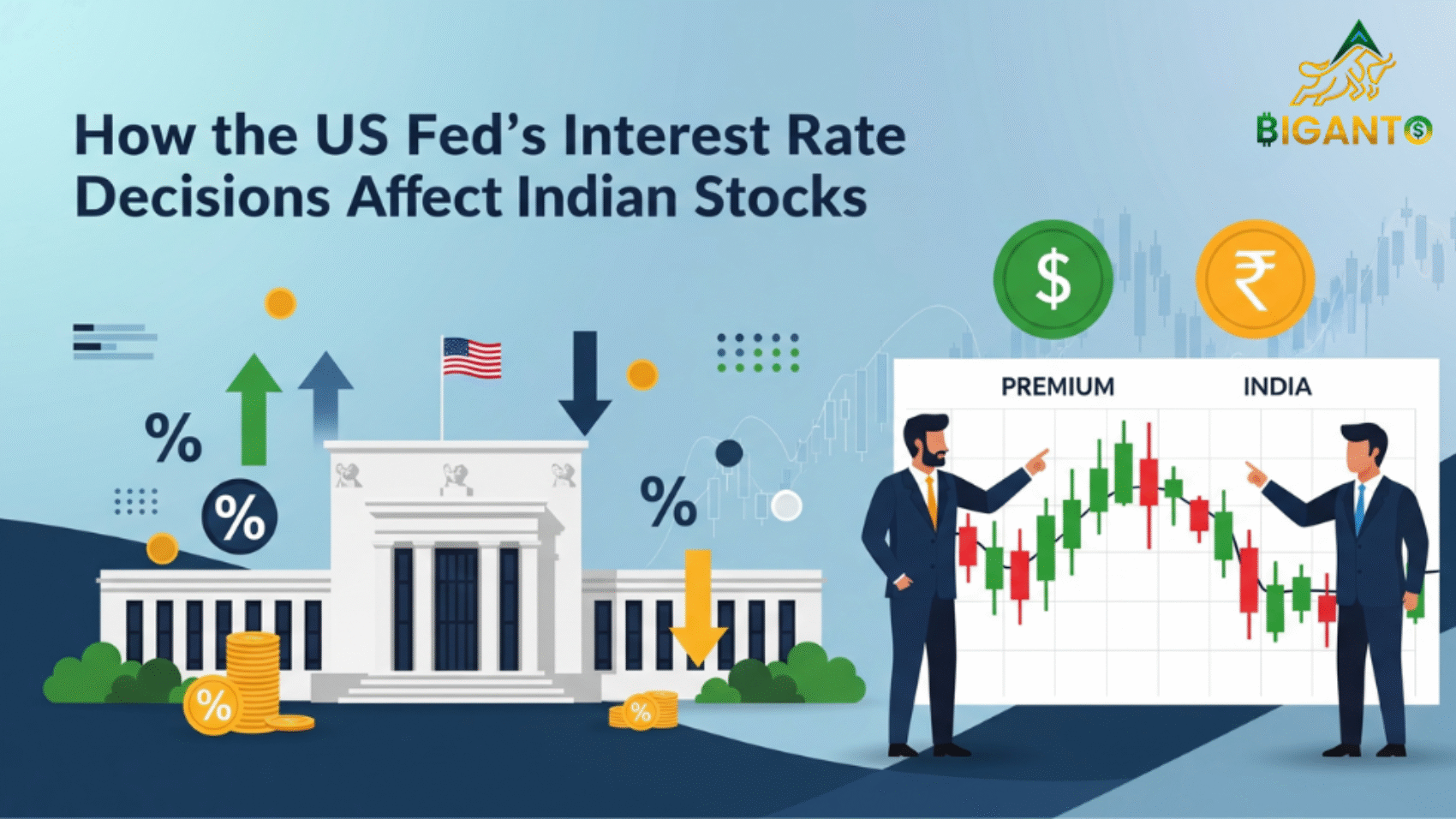Global financial markets are significantly shaped by the US Federal Reserve (US Fed). Monetary policy, which includes the interest rates that banks charge one another for short-term loans, is set by the Fed. The Indian market is greatly impacted by changes in these rates by the Fed, which also have worldwide repercussions. Depending on signals from the US Federal interest rates, the market experiences significant swings on either side when the rates rise or fall by a few base points.
This case study investigates the relationship between Indian stocks and the Fed’s monetary policy, namely rate hikes and rate decreases.
Why Do Changes in US Fed Rates Affect the Indian Stock Market?
US Fed interest rate changes affect the stock market through two key channels: the cost of borrowing and global investment flows.
Keep in mind that US markets frequently offer cheap interest rates to overseas investors looking to borrow money. Then, because of the larger returns, they invest in developing nations like India. For these investors, borrowing costs increase when the US Fed raises interest rates. As a result, they withdraw money from developing nations like India.
On the other hand, borrowing costs go down when the Fed cuts rates. Since investors may now make larger profits, this promotes greater investment in India.
It is important to note that a number of international investors prefer India to the US due to its greater potential for growth. India is a developing country that offers many chances for capital appreciation, while the US is an established market with limited growth potential.
Literature Review
The 2020 Covid-19
The world economy abruptly stopped when the pandemic hit in early 2020. In response, the US Federal Reserve adopted ultra-loose monetary policy, introducing enormous quantitative easing (QE) and lowering interest rates to almost zero. To stabilize markets, trillions of dollars were injected into the system.
This global liquidity flood has a profound impact on India. The Sensex plunged below 26,000 and the Nifty 50 went below 8,000 following the initial crash in March 2020. However, foreign institutional investors (FIIs) made a strong comeback to emerging markets once the Fed implemented its stimulus plan. India benefited greatly due to its enormous potential for expansion.
FII Inflows: In one of the biggest inflow periods in recent memory, FIIs invested billions of dollars in Indian stocks.
Fed’s near-zero rate policy and liquidity support fueled one of the strongest equity rallies India had seen in decades.
Fed Rate Cut After four year (2024)
To help slowing global economy, the US Federal Reserve lowered its benchmark interest rate by 50 basis points in 2024. Ajay Seth, India’s Economic Affairs Secretary, pointed out that this action would not materially change the country’s investment flows. The 2024 rate decrease was viewed as more of a stabilizing move than a liquidity booster, in contrast to previous cycles when rate cuts resulted in significant FII inflows. Due in significant part to domestic institutional investors (DIIs) and India’s solid economic fundamentals rather than Fed-driven capital flows, Indian stocks continued to be strong, with both the Nifty and the Sensex exhibiting consistent gains.
Techniques
This study uses a combination of historical event analysis and market data tracking to examine the impact of US Fed interest rate changes on Indian stocks. The emphasis is on the 2024 rate cut (moderate easing) and the 2020 Covid-19 stimulus (ultra-loose policy).
Foreign Institutional Investors (FIIs): Net inflow and outflow figures from SEBI and NSDL to measure capital movement.
Domestic Institutional Investors (DIIs): Investment patterns to see how domestic capital compensated for shifts in foreign flows.
Analysis
Impact of Fed Rate Hikes on Indian Stocks
When US rates in the US increase. Indian markets saw a decline in foreign investment. This is due to the fact that US returns (such as government bonds) are more alluring than those of the Indian stock market. As a result, international investors return their funds to the United States from India.
Be mindful that the rupee depreciates and the US currency gains strength as a result of rising interest rates. As a result, when foreign investors change their rupee assets back to dollars, they receive a lower return. They become discouraged by such circumstances and frequently choose to move their investments to more favorable markets.
The RBI and Indian investors are also keeping an eye on developments regarding US Fed rates.
The US Fed rates are heavily influenced by the autonomous agency that makes decisions about Indian monetary policy. The RBI has maintained sufficient foreign exchange reserves to counteract the massive outflows of foreign investment that followed a rate hike in the US. Additionally, the Reserve Bank of India makes provisions for interest rate reductions if it still determines that they are necessary, which immediately increases retail involvement.
Impact of Fed Rate Cuts on Indian Stocks
Both the US and Indian markets benefit when the US Federal Reserve lowers interest rates. For instance, in order to prevent a recession, the US Fed lowered interest rates by 25 basis points (0.25%) in November 2019 for the third time that year. Both the Indian and US markets were excited by this. India’s stock market index, or Sensex, reached a record high the day following the rate cut.
If we concentrate on why India gains, it is because a rate drop by the US Fed attracts more foreign investment. while interest rates in the US are low. Foreign investors frequently search other nations for higher profits. India is a rising economy that attracts foreign investors because it provides the chance to earn bigger returns.
Conclusion
There is no denying the effect of Fed rate increases on the Indian stock market. History demonstrates that US Fed monetary policy has a significant impact on liquidity, FII flows, and currency stability. India’s domestic growth narrative is still robust, but cycles of instability are brought on by global shocks from Fed decisions.
An increase in US interest rates has a detrimental effect on the Indian economy and markets. The economy is at risk of increasing inflation, the rupee depreciates versus the dollar, foreign investors withdraw, the market tends to decline, and foreign exchange reserves begin to run out.

